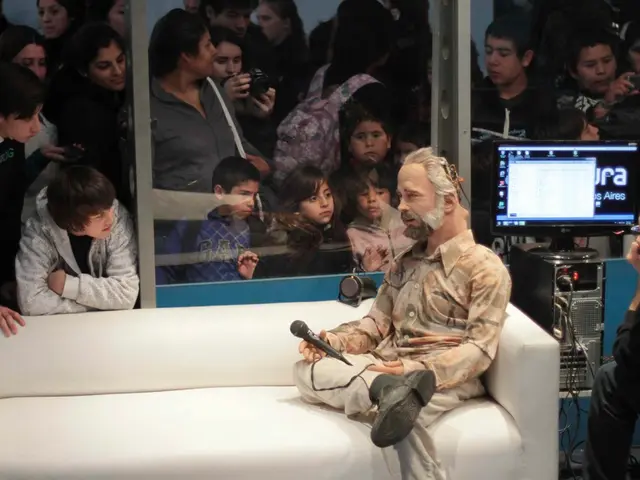A desperate woman turns to bacteria's natural enemies to save her husband's life, bypassing antibiotics
Tom Patterson lay critically ill in a hospital bed, with doctors telling his wife, Stephanie Strathdee, that he had too many bacteria in his body to survive. With hope dwindling, she made a desperate plea that would change their lives forever.
"I said, 'Sweetheart, we don't have much time. I need to know if you want to live. I don't even know if you can hear me, but if you can hear me and you want to live, please squeeze my hand,'" recalled Strathdee, choking up as she recalled the moment.
"Suddenly he squeezes. I say, 'Oh, wonderful!' And then I think, 'Oh, no! What am I going to do?'"
Those words would set in motion a miraculous turn of events that would challenge the medical establishment and offer hope to millions facing the growing threat of antibiotic-resistant superbugs.
The Phage Warriors
Strathdee discovered an unlikely weapon in her fight against the relentless bacteria: a group of tiny viruses called bacteriophages, or phages. These natural enemies of bacteria could potentially be harnessed to combat antibiotic-resistant infections that had left doctors scratching their heads.
She embarked on an odyssey to track down these elusive warriors, reaching out to researchers across the country and making pleas for help. One of them, Ryland Young from Texas A&M University, would become a key ally in their quest for a cure.
"I don't know if I've ever met someone as persuasive as Stephanie," Young said. "We just threw everything out and worked around the clock in search of new phages. The people were working around the clock, digging through a hundred different environmental samples, looking for the perfect ones."
No Problem
As the lab in Texas burned the midnight oil, Scully worked tirelessly to secure permission from the FDA to allow Tom to receive an intravenous phage cocktail. Despite the experimental nature of the treatment, the FDA responded quickly and affirmatively, making arrangements to source phages from the U.S. Naval Medical Research Center.
Armed with the new phage cocktail, Tom's doctors in San Diego proceeded to inject the virus particles into his bloodstream. But they faced an insurmountable challenge: to separate the virulent phages from the toxic bacterial remnants.
"It's like looking for a needle in a haystack," explained Young, a specialist in phage research at Texas A&M. "They give a virus particle into a culture, go home and have lunch, and if they're lucky, they see something that looks like a big blob of liquid full of dead bacteria particles. Those viruses out there – we don't want those. We just want the particles."
The process of purifying phages for intravenous use is still in its infancy in the United States, acknowledged Scully. But both the Marine research center and Texas A&M were up to the challenge, employing various methods to purify the phages enough to be administered intravenously.
"We were pretty sure," Scully said with confidence.
Additional hurdles, however, emerged. Attorneys at Texas A&M expressed concerns about potential lawsuits in the event something went wrong. But Strathdee and her team were determined to move forward.
With the sheer force of will and the assistance of her contacts at the university, the legal concerns were alleviated, and everyone worked together to ensure the safe and effective delivery of phages to Tom.
"It was like the Red Sea splitting," said Young. "The paperwork and all the discussion just vanished. Everybody started working together."
The Miracle Cure
The first batch of purified cocktails from Young's lab arrived in San Diego, where they watched as doctors injected Texas-phages into Tom's abscess-filled body. Over the following days, they continued to administer the Marine cocktail to treat the bacteria that had spread throughout his body.
"We began with an abscess, because we didn't know what we were dealing with, and we weren't going to let him die," recounted Scully. "We didn't see any negative effects; in fact, it seemed that Tom's condition was stabilizing, which is why we continued to treat him."
Two days later, doctors injected the Marine cocktail into Tom's bloodstream. Less than 72 hours later, Tom awoke from his coma and kissed his daughter's hand.
"It was just magical," an emotional Strathdee said. "He's just a miracle."
Salvaging a Life
Today, eight years later, Tom is living out his days in retirement, walking three miles each day and working in his garden. But the long ordeal has left its mark: a diagnosis of diabetes, heart issues, and gastrointestinal problems have made his days fraught with challenges.
"He's not surfing anymore, because he can't feel the bottom of his feet," Strathdee said. "And in April, he got Covid-19, which put him in the hospital because he only had half a lung left."
Despite the setbacks, recovering from a near-fatal infection that had eluded modern medicine's traditional antibiotic arsenal has given the couple a new lease on life. They continue to travel the world, looking forward to their next adventures.
"We're going to Chile in January," Strathdee said with a smile. "We're going with a friend who's a doctor specializing in infectious diseases, just in case something happens. In a sense, I'm like a helicopter nurse, but we've already been to Costa Rica and Africa."
The Phage Miracle
The story of Tom and Stephanie’s journey to beat antibiotic-resistant superbugs has inspired worldwide interest and research, pushing the boundaries of phage therapy.
The couple published a book in 2019, "The Perfect Predator: A Scientist Saves Her Husband from a Deadly Superbug," sharing their experiences and offering a glimpse into the potential of phages in the fight against antibiotic resistance.
Tom's shocking case – published in the journal Antimicrobial Agents & Chemotherapy in 2017 – has sparked renewed interest in the use of phages to combat infections.
"There is an explosion of clinical phage research taking place around the world," said Strathdee, citing projects underway in Canada, the UK, Australia, Belgium, Sweden, Switzerland, India, China, and several other countries.
One area of focus for researchers is the interaction between phages and antibiotics. When bacteria fight back against phages by shedding their outer shells, they can inadvertently become vulnerable to antibiotics. This synergistic approach could enhance treatment efficacy for those battling antibiotic-resistant infections.
"We don't believe that phages will fully replace antibiotics," said Strathdee, "but they will make a great addition to antibiotics. In fact, they could even improve the effectiveness of antibiotics."
A Unique Partnership
The groundbreaking work of the Patterson-Strathdee partnership in the field of phage therapy led to the establishment of the Innovative Phage Applications and Therapeutics Center (IPATH) at UC San Diego in 2018. The center's high success rate – with 82% of patients reporting clinical improvement after phage therapy – is diagnostic of its impact.
Dr. Randy Taplitz, a founder of IPATH, is now conducting clinical studies with phages to treat mucoviscidosis patients facing infections by the antibiotic-resistant bacterium Pseudomonas aeruginosa. His work builds upon the pioneering work of Tom and Stephanie, providing a shining example of what's possible when science meets courage.
"That's just a historical accident that only someone like Tom and Stephanie could have experienced," Young said. "They were at UC San Diego, one of the best universities in the country. They worked with a brilliant doctor for infectious diseases who said 'yes' to phage therapy, whereas most doctors would have said 'no' – I wouldn't have done it.
"Then there's Stephanie's energy and enthusiasm – it's almost mysteriously attractive. It's like a web she casts; she's in the middle, and she draws in everyone else."
Read also:
"Stephanie and Tom were looking for phage treatments to battle the superbugs that had attacked Tom."
"Phages, or bacteriophages, offer a promising biologically innovative approach to treating infections that are no longer responsive to traditional antibiotics."
Enrichment Data:
Bacteriophages, or phages, could provide a biologically innovative approach to treating infections that are no longer responsive to traditional antibiotics. Phages offer several advantages in combating antibiotic-resistant bacteria, including:
- High specificity: Phages are highly specific to their bacterial hosts, reducing the risk of developing resistance and eliminating harmful side effects.
- Different mode of action: Phages use a different mechanism to combat bacteria than antibiotics, making it less likely for bacteria to develop resistance. The case of Tom Patterson offers a great example of this, as phages targeted the bacteria that were resistant to traditional antibiotics.
- Personalized treatment: Phage therapy can be tailored to individual bacterial infections, enhancing treatment efficacy by targeting specific strains of antibiotic-resistant bacteria.
- Combination therapy: Phages can be used in combination with antibiotics, resulting in enhanced treatment efficacy.
- Environmental applications: Phages can be used to control bacterial diseases in agriculture, aquaculture, and wastewater treatment, leading to reduced antibiotic consumption and reduced antibiotic resistance.
- Research and development: Ongoing research is focusing on the full potential and mechanisms of phages for treating various antibiotic-resistant bacteria. This includes developing standardized phage therapy protocols and exploring their effectiveness from a One Health perspective.
Phages have the potential to play a vital role in combating antibiotic resistance, offering a different approach to traditional antibiotics.








